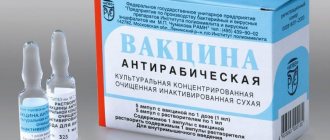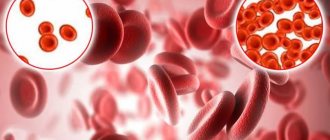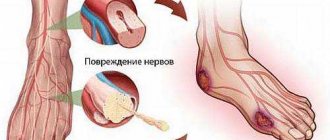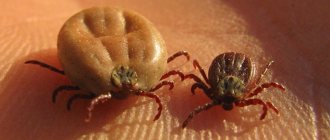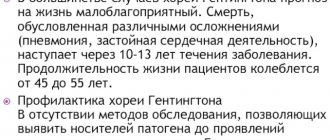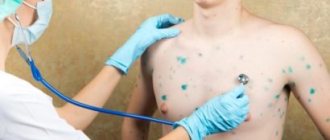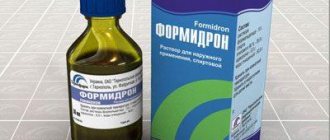Infectious disease specialist
Sinitsyn
Olga Valentinovna
33 years of experience
Highest qualification category of infectious disease doctor
Make an appointment
Contact with aggressive wild or domestic animals carries the risk of contracting rabies. This extremely dangerous disease is caused by the Rabies virus, which infects cells of the human nervous system and brain. In the active phase, it occurs quickly and with severe symptoms, and the probability of death is almost 100% in the absence of preventive measures.
Features of the virus
The disease is especially common among stray and wild animals that gather in packs. People encounter it much less often, but this does not make rabies any less dangerous. According to the ICD, the disease has code A82 and belongs to the category of viral infections, since its development is associated with the spread of the Rabies virus contained in the saliva of infected animals. In some cases, it can be found in tear fluid or urine.
The pathogen is transmitted to a healthy person immediately after contact with a sick animal. It penetrates from saliva into superficial tissues, after which it begins to actively multiply within the nearest muscles and causes irreparable damage to the peripheral nervous system. Gradually, the virus begins to move to the central nervous system, and then rises up the spinal cord. In parallel with this, the person’s condition begins to deteriorate noticeably. When the pathogen manages to reach the brain, severe encephalitis begins to develop. After this, the patient becomes extremely ill. At the same time, the virus enters the salivary glands, which makes the victim dangerous to others.
Spread through nerve cells occurs slowly. Therefore, the disease does not show the first symptoms immediately. Typically, the speed of its movement within the body does not exceed 3 mm in one hour. At the same time, the virus is afraid of elevated temperatures. It dies when exposed to air heated to 56 °C in about 15 minutes. Boiling it in water kills it in a couple of minutes. It can also be destroyed using ethanol or disinfectants. But all these remedies are unable to help if the causative agent of the disease has already entered the body.
WHO statistics say that at least 55 thousand people die from rabies every year around the world.
Causes of rabies
Rabies (hydrophobia) is an acute contact zoonotic infectious disease caused by a neurotropic virus and characterized by the development of a kind of encephalitis with fatal damage to the central nervous system.
In the medical literature of other countries, the disease is known as rabies when it develops in animals, and hydrophobia when it comes to human diseases. The names come from Lat. rabies (derived from the Sanskrit words rabas - riot; rabere - dream) and hydrophobia - fear of water. To determine the genus to which the rabies virus belongs, the name Lyssavirus is used (from the Greek Lyssa - the name of the goddess of madness, rage and fury).
Since the late 1990s, due to the high level of immunization of wild animals in Western and Central Europe, the epicenter of rabies has moved east to Poland, Croatia, Russia, Belarus, Ukraine, and Latvia. In recent years, the epizootic situation in Ukraine has worsened significantly. Active foci of natural rabies exist throughout Ukraine, most of them are registered in Chernigov, Sumy, Poltava, Kharkov, Khmelnytsky and Lugansk regions. The increased incidence of rabies among dogs, cats and farm animals is, first of all, an indicator of epizootic troubles among wild animals. The situation is complicated by the increase in the number of stray dogs and cats in populated areas, incomplete coverage of preventive vaccinations for domestic animals, and violation of the rules of keeping their owners. All this is a prerequisite for the formation of urban-type rabies cells, which in turn increases the threat of the emergence and spread of this infection among the population.
Thus, in Ukraine, about 110 thousand people annually seek medical help for animal bites, of which almost 20 thousand receive rabies vaccinations. In recent years, isolated cases of rabies in humans have been recorded, due to the delay in seeking medical help from victims of animal bites.
RNA genomic virus Rabies virus from the group of myxoviruses of the Rhabdoviridae family, genus Lissavirus. The virion is spherical in shape and contains single-stranded RNA. A characteristic feature of the morphology of the rabies virus is the presence of glycoprotein spikes on the lipoprotein envelope. The nucleocapsid has an RNA polymerase. The virus contains 5 main proteins:
- a stable outer envelope glycoprotein consisting of more than 300 different trimmers; helps the virus penetrate the target cell, induces the formation of virus-neutralizing antibodies and determines a single antigenic variant of the virus;
- intraenvelope matrix protein;
- nuclear protein that stimulates the formation of complement-fixing antibodies;
- internal large protein - transcriptase;
- internal small protein - phosphoprotein.
The complete antigenic homogeneity of rabies viruses has been established, which made it possible to create a highly effective rabies vaccine. The rabies virus is exclusively tropic to neurons of the brain and spinal cord, as well as tissues of the salivary glands. It is capable of active replication in the brain matter of warm-blooded animals, which is why intracerebral infection of mice or rabbits has recently been used in virological studies. The virus is now usually cultivated in primary and continuous cell cultures or in chicken embryos.
There are two known variants of the virus:
- street (wild), circulating in natural conditions among wild animals,
- fixed, obtained during laboratory tests.
The fixed rabies virus after parenteral administration causes an experimental disease with a short (7-day) incubation period, has a 20-30 times lower infectious dose, does not form Negri bodies in the brain, and is not detected in saliva; and due to its preserved immunogenicity, it is used to obtain rabies vaccines.
The rabies virus is unstable in the environment:
- inactivated by heat (boiling destroys it in less than 2 minutes),
- under the influence of the Ural Federal District,
- under the influence of alcohol, commonly used disinfectants,
- Once frozen, it can be preserved for several years.
In addition to the rabies virus, the genus of Lyssaviruses includes 10 more species, grouped into 7 main genotypes according to phylogenetic origin. All other viruses of this genus are capable of causing diseases in humans with damage to the central nervous system, which sometimes closely resemble the symptoms of classical rabies. For most of these viruses, bats are the main source.
The source and reservoir of the rabies pathogen are wild and domestic predatory animals belonging to the class of mammals. There are natural foci of rabies that form wild animals (wolves, foxes, badgers, raccoon dogs, mongooses, mice, rats, bats, hedgehogs, jackals, arctic foxes, skunks, and also vampire bats in Central and South America), and anthropurgic cells supported by dogs, cats, and farm animals.
The greatest danger comes from stray animals. Animals for which a bite is an instinctive reaction of everyday life (predators) are the most dangerous representatives of the fauna in terms of transmission of infection. Some small mammals (bats, mice, rats, etc.) do not show signs of severe illness and can excrete the virus in their saliva throughout their lives.
The mechanism of infection is contact, the route of transmission is wound. A person becomes infected when bitten by a rabid animal or if its saliva gets on damaged skin and/or mucous membranes, less often when skinning the corpses of rabid animals, especially foxes.
The animal's saliva becomes contaminated in the last 7-10 days of the incubation period and remains so throughout the entire illness. The possibility of aerogenic infection has been proven (in laboratory conditions, when visiting caves inhabited by bats), when the virus enters through damaged areas of the conjunctiva and mucous membranes of the mouth and throat.
In recent years, isolated cases of iatrogenic contact infection of people due to corneal, kidney or liver transplants from deceased donors in whom rabies as the cause of death was not established have been described. Rabies occurs on all continents except Antarctica. The disease is not registered in some island countries: Japan, New Zealand, Cyprus and Malta, as well as in the Scandinavian countries (Norway, Sweden, Finland) and on the Iberian Peninsula (Spain, Portugal). Natural foci of rabies have been eliminated on the islands of Great Britain, Ireland, and Iceland.
Susceptibility to rabies is general, but mainly rural residents are affected; the urban population accounts for up to 20-25% of cases. Men get sick more often. Not all people bitten by a rabid animal develop the disease. The development of the disease depends on the location, size of the wound and the dose of the virus that has entered the body. Thus, when a virus enters the conjunctiva of the eyeball, it causes disease in the absence of immediate preventive measures in almost 100% of people; when bitten on the face, rabies occurs in 99%, on the hand in 63%, on the proximal limbs in 23% of people, so a false impression is created, that some people are relatively resistant to this infection. In total, about 15-30% of those bitten get sick, but every sick person dies.
Thanks to widespread vaccination of people at risk of developing rabies, the incidence continues to decrease. A person with rabies is a biological dead end of the natural epidemic process.
As a result of post-traumatic penetration of the virus into muscle and connective tissue, its primary replication occurs at the site of inoculation (mainly striatal muscle cells), which is usually associated with the so-called viral latency, since this process can drag on for several months. Much faster, the virus accumulates directly in the peripheral nerves that innervate damaged tissue, especially when infected through the conjunctiva and mucous membranes. In this case, the duration of the incubation period is significantly reduced (up to 7 days) if a larger number of nerve fibers and receptors are damaged.
A shorter incubation period is observed with deep bites of the most innervated areas of the body: head, face, neck, fingers, genitals. When areas that are poorly innervated are affected, it can lengthen significantly. Due to the likelihood of such a long incubation period (1 year or more) and the always fatal consequence of rabies in humans, it is classified as a group of so-called slow infections.
It is important that during the incubation period of the pathogen, the body’s protective immune reactions are not yet triggered. At the site of primary reproduction of the virus, degenerative changes in nerve receptors develop, accompanied by hyperesthesia in the wound area. Due to its neurotropism, the pathogen first penetrates the perineural cavity of the afferent nerves, and then moves along their axons at a speed of 12-24 mm/day until it enters the dorsal ganglion. Its reproduction in the ganglion is accompanied by the appearance of pain or paresthesia at the site of inoculation; these are the first clinical symptoms to which patients usually do not pay much attention.
Only this process begins the synthesis of antibodies against the rabies virus, so they can be detected in the blood and cerebrospinal fluid only after the first symptoms of the disease appear. However, under such conditions, the death of the patient occurs before the titers of virus-neutralizing antibodies reach a protective level. Damage to the neurons of the corresponding structures leads to an increase in reflex excitability, and consequently to the development of paralysis.
Damage to the nuclei of the vagus, glossopharyngeal and hypoglossal nerves causes spasms of the respiratory and pharyngeal muscles, which are very characteristic of rabies: when trying to swallow saliva or water, extremely painful, uncoordinated contractions of the throat muscles occur. In turn, this leads to the rapid formation of a conditioned reflex - any mention of water is associated with severe pain. This is how the “calling card” of rabies is formed - hydrophobia.
Increased excitability of the autonomic centers subsequently leads to paroxysmal contraction of the throat muscles in response to any external stimuli. Typical hydrophobia is often accompanied by aero-, photo-, and acoustic phobia. Irritation of the sympathetic nervous system causes increased salivation, sweating and lacrimation, and damage to the vagus nerve causes disruption of the cardiovascular system.
The virus spreads centrifugally along the efferent fibers of the peripheral nerves to various organs and tissues, accumulating primarily in the salivary, lacrimal glands and cornea. The pathogen also penetrates the lungs, adrenal glands, kidneys, skeletal muscles, pancreas, and mammary glands (excreted in milk).
The inability to swallow saliva leads to its spitting, widespread splashing during periods of excitement during paroxysms, and can, under certain conditions, lead to hypothetical infection of others. Subsequently, degenerative degeneration of peripheral motor neurons causes flaccid paresis and paralysis, cerebral edema (progressive encephalomyelitis) predetermines the patient's fall into a coma and inevitable death due to respiratory arrest and/or acute heart failure.
In the deceased, changes are found primarily in the brain and spinal cord. By multiplying in the nervous tissue, the virus causes characteristic changes in it - swelling, hemorrhages, degenerative and necrotic processes. The histological picture indicates focal encephalitis with proliferation of neuroglia, forming miliary granulomas (which can sometimes be observed in other diseases) - “rabies nodules”.
The incubation period for rabies ranges from 7 days to more than 1 year, with an average of 30-90 days. Clinically, typical and atypical forms of rabies are distinguished.
The typical form goes through three successive stages: precursor, excitation, paralytic. The first signs of the disease in the precursor stage almost always appear at the site of the bite. The scar often swells, turns red, becomes painful, and itches. The pain often spreads along the corresponding nerves innervating the muscles near the scar. Patients experience causeless fear, melancholy, anxiety, increased sensitivity to sound and light stimuli, and a slight increase in body temperature. Sleep is disturbed, nightmares disturb, and later insomnia. Patients are reluctant to come into contact, complain of general weakness, loss of appetite, dry mouth, increased sweating, palpitations, moderate sore throat when swallowing, and sometimes nausea and vomiting.
Those around them pay attention to the change in the character of patients, as they become gloomy, picky, rude in relationships, with alternating periods of unmotivated excitement and depression; during this phase they often wander alone. On examination, a certain expansion of the pupils, moderate symptoms in the throat, a frequent labile pulse, and increased heart sounds are detected. After 2-3 days, the stage of excitement begins. Anxiety increases, symptoms of excessive reflex excitability of the breathing and swallowing centers appear. Severe tachycardia is also characteristic. The face is cyanotic, the eyes are fixed on one point; exophthalmos appears, the pupils are significantly dilated. The patient is thirsty, but when trying to get drunk, extremely painful spasms of the muscles of the throat and larynx suddenly occur; such symptoms are subsequently caused by the very sight of water, its murmur, and verbal reminders of it (typical hydrophobia). At this time, the respiratory muscles also contract spasmodically, which causes difficulty breathing. Inhalation is significantly difficult, with the participation of all auxiliary muscles, accompanied by a kind of whistling or snoring, exhalation is superficial and imperceptible. After a few seconds, muscle spasms disappear and breathing is restored. The patient complains that he “doesn’t have enough air” and cannot swallow. Over time, spasms develop more often and last longer (sometimes up to 1-2 minutes), occur not only from water, but also from the movement of air, previously cold (aerophobia), bright light (photophobia), loud speech or strong sound (acousticophobia) .
Patients sometimes rush about, often jump out of bed, tear their clothes, try to run somewhere due to suffocation, and occasionally become aggressive; visual and auditory hallucinations are added. There is an expression of horror on the face, the voice is hoarse, profuse sweating. Due to difficulty swallowing and increased salivary secretion, significant drooling is often observed. Body temperature rises to 40-41 °C. The excitation stage lasts 2-3 days, rarely up to 6 days, and can result in death due to prolonged cessation of breathing or cardiac arrest. But more often the disease passes into the paralytic stage, which lasts up to 10 days.
The attacks of excitement stop and an “ominous” calm sets in; Sensitivity and motor function are sharply weakened. Paralysis, as a rule, is flaccid, starting from the legs (characteristic ascending paralysis of the Landry type). At this stage, the patient lies motionless, his face is cyanotic, his features are pointed, and beads of sweat cover his entire body. Due to paralysis of the oculomotor nerves, the pupils dilate significantly and stop responding to light. The function of the pelvic organs is impaired, accompanied by urinary retention or incontinence. Due to the disappearance of excitement and convulsions, breathing becomes easier. Often patients can swallow and drink, but the body temperature rises to 42 ° C and death soon occurs due to paralysis of the heart or respiratory center.
Atypical forms include bulbar, paralytic (“silent” rabies), meningo-encephalitic, cerebellar. Accordingly, the disease begins without warning, with excitement or immediately with paralysis, and can occur with pronounced signs of damage to the medulla oblongata (breathing disorders, dysphagia) and the cerebellum (dizziness, ataxic gait), and the psyche (delirium, manic-depressive psychosis). The disease always ends in death.
Vectors
Despite understanding the dangers of rabies and the fear of dying from such a disease, many people do not attach much importance to situations where they come into contact with a wild or strange animal. Therefore, some go to the hospital too late, which leads to disastrous results. You should think about the risks and go to the doctor immediately after interacting with any creature that could become a source of the virus.
Most often, stray dogs and cats, foxes, bats, hedgehogs, rats and other rodents become carriers of the disease. Slightly less commonly, the virus can be transmitted by birds, fleas, wolves, badgers and raccoons. Infection from other animal species is possible. Pets can also become a source of rabies and begin to infect everyone around them. Dog owners who take them for walks in parks or take them into the forest to hunt are most at risk.
The symptoms of rabies in humans have a number of similarities, but not everyone can recognize a rabid animal on the street. This is often difficult to do, since non-standard behavior may be a character trait. The easiest way to identify the disease is in pets. At the beginning of the disease, they become secretive, avoid people and hide from prying eyes. Later, their excitement increases, which is why the pets begin to angrily grab and spoil things or attack their owners. The last stage is characterized by immobility and coma, which gradually develops into death. In this case, the disease can be expressed in three forms:
- violent - the animal shows serious aggression, which later leads to convulsions, paralysis and death;
- quiet - there is no aggression, salivation increases, the animal cannot eat and falls into a coma, after which it dies;
- atypical - the animal suffers from constant diarrhea, other symptoms are practically absent, the condition often improves, but in the end death still occurs.
The most common form is the violent form. It is considered the most dangerous both for the animal itself and for others. It is very easy to recognize it when it manifests itself in pets. Stray dogs, for example, can already be aggressive. But sometimes the disease forces them to change their behavior, becoming more friendly, which should be seriously alarming.
Questions for the doctor
Squirrels and rabies Hello! Yesterday we walked in the park with our 1 year and 5 month old child and fed the squirrels. I was a little distracted, and then I noticed a slight redness on my son’s hand, more like a scratch. The child doesn’t really speak yet, so I couldn’t get him to tell me what happened. Now I'm very worried. Can squirrels carry infections? When does rabies appear after a bite? Should a person be given a rabies injection after a squirrel bite?
Hello! Like other small rodents, squirrels can be a source of rabies, but the chance is negligible. Therefore, it is difficult to become infected from them, especially through scratching. Just treat the wound with an antiseptic.
Incubation period of the disease Hello! A week ago, a cat bit me at the dacha. She is not completely homeless, rather “common” - we feed her with the whole village. Then I didn’t pay much attention to it, I just washed my hands with soap and treated the bite marks with iodine. Now I’ve read a lot on the Internet about rabies, and I’m very worried. Is it too late to get vaccinated? And is it necessary? I see that cat every day, behaving as usual.
Hello! Rabies is an extremely dangerous disease that, without timely treatment, leads to death in almost 100% of patients.
You should definitely go to the nearest emergency room to start vaccination. If after 10 days the cat is alive and has no symptoms of the disease, treatment can be stopped.
Routes of infection
Signs of rabies infection may appear in an animal 10 days after it becomes infectious. Therefore, it would be a mistake to determine the degree of danger by his behavior. With simple contact with a sick animal, limited to touching or even licking intact human skin, there is no need to be afraid. Infection occurs only in several ways:
- penetration of the virus by airborne droplets - through saliva and air during human inhalation;
- contact of infected saliva with damaged skin or mucous membranes of a person - most often occurs through a bite or contact of saliva with a scratch;
- processing of corpses or biological materials with the virus - any contact of unprotected skin with animals that died of rabies or their tests;
- transplacental - transmission of the virus from mother to child through the placenta during pregnancy.
Often the cause of infection is a simple bite. But not only any stray dog, but also a pet can bite a person. There are cases when a small puppy began playfully biting its owner and transmitted the virus to him. A child can also get the disease. For example, if a donated kitten accidentally gets infected on the street and then decides to lightly scratch the baby’s finger while playing. In the latter case, transmission of the virus will occur provided that before this the pet licked its paws, which is why saliva with the virus got onto the claw.
The possibility of contracting the virus from another person has not yet been proven or disproved.
The path to salvation
According to Rospotrebnadzor, every year in Russia from 250 to 450 thousand people who have suffered from animal bites receive anti-rabies treatment, about a quarter of whom are children. The following rabies vaccines are used in our country: Rabivak-Vnukovo-32 Culture-inactivated rabies vaccine for human immunization (FSUE NPO Microgen of the Russian Ministry of Health); KOKAV Anti-rabies vaccine, cultured, concentrated, purified, inactivated (FSUE NPO Microgen, Ministry of Health of Russia); Rabies vaccine culture concentrated purified inactivated dry (Enterprise for the production of bacterial and viral preparations of the M.P. Chumakov Institute of Poliomyelitis and Viral Encephalitis of the Russian Academy of Medical Sciences Federal State Unitary Enterprise). Rabipur is also registered in Russia (Novartis Vaccines and Diagnostics GmbH and Co.KG, Germany). The total market capacity of the Russian Federation (treatment + prevention) is in the range of 1.8–3 million doses.
In accordance with WHO recommendations, the immunological activity of the domestic non-concentrated vaccine (CAV) is at least 0.5 IU/ml, and the concentrated COCAV vaccine is at least 2.5 IU/ml. According to Rina Timerbaeva, deputy director for production and technology of the branch of the Federal State Unitary Enterprise NPO Microgen of the Ministry of Health of the Russian Federation Immunopreparat (Ufa), the use of COCAV made it possible to reduce the number of injections (up to 6 times) and administration doses (from 5 ml in 2 places to 2 .5 ml to 1 ml per injection). This significantly reduces the antigen load, reduces adverse reactions and post-vaccination complications. The local reaction is characterized by slight swelling, redness, itching, and enlargement of regional lymph nodes. The general reaction can manifest itself in the form of malaise, headache, and weakness. In very rare cases, the possibility of neurological symptoms is expected. In this case, the victim should be urgently hospitalized so as not to miss the development of encephalitis.
“Post-vaccination complications are caused, first of all, not by the insufficient quality of the domestic drug, but by the intensity of the immune response, individual characteristics and reactivity of the vaccinee,” Rina Timerbaeva is sure. Therefore, when carrying out urgent rabies prophylaxis, it is worth abandoning the search for imported vaccines, since delay can cost lives. For preventive immunization, it is possible to use an imported vaccine if there is time and money to find it.
Article on the topic
World Rabies Day. What to do if you are bitten by an animal? When summarizing observations of vaccinated people (1,708 cases), an amazing pattern emerged: vaccination with the Fermi rabies vaccine stimulates the immune system, as evidenced by a sharp decrease in the number of cases of bronchial asthma, gastric ulcers, collagenosis, herpetic lesions and periodontal disease, while influenza and ARVI were milder.
Anti-rabies immunoglobulins, which are the second component of urgent rabies prevention, are divided into homologous, obtained from human donor blood, and heterologous, obtained from the immune blood of horses. The negative side of all heterologous AIH is the risk of developing allergic complications. After the administration of rabies immunoglobulin, anaphylactic shock and a local allergic reaction may occur, since it is produced on the basis of horse protein. Its administration is recommended in a hospital setting. The homologous drug "Imogam Raj" produced in France is registered in some CIS countries. However, it is almost inaccessible due to its high cost and small production volume, which are caused by the objective difficulties of immunizing volunteers and the insufficient raw material base. There are no plans to produce homologous AIG in Russia in the near future.
Experts emphasize that rabies remains a real and formidable danger. According to the Ministry of Health, of those who died from hydrophobia in 2008–2011, 40 people (70.2%) did not seek medical help and, accordingly, did not receive timely anti-rabies treatment; 10 people (17.5%), having sought medical help on time, refused anti-rabies treatment. In one case, after dangerously localized bites inflicted by a wolf, rabies immunoglobulin was not prescribed, which contributed to the development of the disease.
“Despite the apparent simplicity of specific anti-rabies treatment, quite often there are serious violations in the prescription and implementation of a course of anti-rabies treatment, associated primarily with unsatisfactory knowledge of the instructions for using the drugs,” says Rina Timerbaeva. Only active educational work among the population, as well as improving the qualifications of medical workers, can reduce mortality.
Figures and facts
The average annual number of rabies cases in animals is highest in Europe and South America and lowest in Africa, while the incidence rate in humans is highest in Asia and lowest in North America. Rabies kills more than 55,000 people each year, mostly in Asia and Africa. At the same time, more than 15 million people in the world receive vaccination to prevent the development of the disease. This prevents hundreds of thousands of deaths from rabies each year. In the first quarter of 2013, animal rabies was detected in 37 constituent entities of the Russian Federation, including Moscow and the Moscow region. Traditionally, St. Petersburg and the Leningrad region remain rabies-free. The sad leaders are Belgorod region (79 cases in animals), Saratov region (64 cases), Moscow region (40), Voronezh region (37) and Tambov region (36). Two people fell ill (and died) in the Kursk and Vladimir regions.
Symptoms
Several factors can influence the likelihood of developing rabies, including the type of animal infected, the amount of virus ingested, and the state of the person's immune system. The largest percentage of disease transmission occurs through bites of the head and foot, since they contain many nerve endings. Rabies can develop over a long period of time. Most often, the incubation period ranges from one to three months, but sometimes the disease can appear as early as the tenth day or, conversely, drag on and make itself felt a year later. Rabies occurs in three stages. Each of them has its own symptomatic characteristics.
The first signs of rabies in humans at the initial stage last from one to three days. At this time, the patient begins to be very worried about the wound. This happens even in cases where it has already healed. A person feels it, he has a nagging pain, the skin becomes very sensitive, itches and may turn red. There may also be a headache, and weakness often develops, accompanied by nausea. Body temperature remains at 37 °C, appetite disappears, and sleep is disturbed. The patient may become depressed and begin to fear normal things. If the infection occurs through the head, then hallucinations are added to the symptoms.
The second stage lasts up to three days and can be severe. The main symptom of the disease is severe hydrophobia. The patient is categorically afraid of water - he may panic even at the mere suggestion of drinking water or washing his hands. Sometimes spasms of the larynx may begin with difficulty breathing if he simply hears a dripping faucet. At the same time, the person becomes extremely sensitive to any other stimuli. He may experience severe convulsions from wind, light or loud noise.
At the same time, the patient’s eyes protrude, the pupils become wide, and the gaze freezes. At the same time, saliva flows from the mouth. This stage is also accompanied by the manifestation of strong aggression. The patient may rush at others to beat or bite, tear his clothes, scream loudly, and hit walls. Often, during an attack of aggression, a person’s heart stops, which is why he dies. If he remains alive, then his consciousness clears up and becomes normal again.
The third stage can last no more than a day. At this time, the patient will experience paralysis of the body, due to which he will not be able to move. At the same time, the body temperature rises to 40 °C, the pressure drops, and the heart rate increases sharply. Soon paralysis overtakes the heart or lungs, as a result of which vital functions cease to be performed and the person dies.
Medicines
Photo: 1.hvylya.net
Painkillers are used to relieve pain. Of the group of non-steroidal anti-inflammatory drugs, ketorolac has the greatest analgesic effect. The pronounced analgesic effect of the drug is achieved due to non-selective inhibition of the activity of cyclooxygenase (COX) 1 and 2, which are involved in the formation of prostaglandins from arachidonic acid, which, in turn, play an important role in the mechanism of pain formation. The analgesic effect of the drug begins 30 minutes after intramuscular administration, the maximum effect is achieved after 1 - 2 hours.
If the use of ketoroloc does not eliminate pain, narcotic analgesics (morphine, promedol) are used to help. Morphine inhibits the transmission of pain impulses to the central nervous system, reduces the emotional assessment of pain, causes a feeling of calm, and in high doses the drug can have a hypnotic effect. When the drug is administered intramuscularly, the analgesic effect develops after 10–30 minutes and continues for the next 4–5 hours. Promedol also belongs to the group of narcotic analgesics, but its analgesic effect is somewhat weaker and shorter in duration than that of morphine. The analgesic effect develops 10–20 minutes after administration of the drug, reaches a maximum after 40 minutes and lasts 2–4 hours.
Diazepam (Relanium, Seduxen) has anticonvulsant activity. In addition to the anticonvulsant effect, this drug has sedative, hypnotic, and muscle relaxant effects. While taking the drug, a decrease in blood pressure may be observed due to vasodilation, so it is used with caution in hypotensive patients.
Even at the initial stage of the disease, there is a sleep disorder, which is expressed in intrusive, frightening dreams, as a result of which the person is afraid to fall asleep. Therefore, sleeping pills, such as zopiclone, are prescribed. This drug causes a rapid onset of sleep, and also relieves a person from drowsiness and a feeling of weakness in the morning. In addition, zopiclone has been found to improve sleep quality and also reduce the frequency of awakenings at night. In addition to the hypnotic effect, this drug has sedative, muscle relaxant, and anticonvulsant effects. The drug is taken 1 hour before the expected onset of sleep.
First aid and diagnostics
Immediately after contact with an animal that may be infected with the virus, you need to act. Despite the severe pain, you should wash the wound with warm water and soap, treat its edges with alcohol and go to the hospital. A visit to the doctor should be urgent. It is advisable to go to him immediately or at least on the same day, without delaying time. If it is not possible to treat the wound or go to the clinic on your own, then you should call an ambulance. It is also recommended to do this in all cases where it is quite far from home and it will not be possible to wash the wound in the next few minutes.
After going to the doctor, you should collect all the necessary information about what happened. The patient will have to describe the animal and all the circumstances of contact with it. This will help to pre-assess the risks. If possible, the infected animal will be kept under observation for 10 days to look at its condition.
Your doctor will check for rabies by examining your medical history and laboratory tests. To do this, it will be necessary to detect the presence of antibodies in the blood and antigen in the corneas or skin biopaths. Sometimes, if a person does not inform the doctor about the fact of contact with a suspicious animal, rabies is confused with other diseases. Therefore, the patient may be prescribed additional diagnostics. After this, it will be possible to clearly understand what kind of diagnosis to make and what treatment to prescribe. The presence of the virus can also be determined by analyzing the brain after the death of the patient.
Treatment
Previously, all treatment for rabies was limited to alleviating the patient's condition so that he would experience less suffering before death. It was possible to save the patient's life only if therapy was started before the first symptoms appeared. Since 2005, rabies in humans has become less dangerous, since it has become possible to save a person after a serious deterioration in his condition. The prognosis for most patients who consult a doctor in the first days after contact with an infected animal is most often favorable. For those who have delayed it, it becomes more negative every day. In the later stages, recovery is almost impossible, and the average lifespan from the onset of symptoms is several days. Therefore, it is very important to start treatment early.
The treatment regimen requires mandatory vaccination. A special agent is injected into the patient’s blood immediately after visiting the doctor. Then it is repeated on days 3, 7, 14 and 28. WHO recommends vaccination also after three months to minimize risks. Injections are given into the deltoid muscle. For children, the substance is administered through the thigh. This method is used if a person is bitten or scratched by an animal that may have rabies. The vaccine is also administered when injured by an object where there may be contaminated saliva. If there was contact without damaging the skin with a bird or domestic rodent, then the person is not given injections.
The method is effective only in the first two weeks after infection. To cure the disease, you do not need to go to the hospital. The only exception is pregnant women. During therapy, the following are prohibited: drinking alcohol, overwork and visiting the bathhouse. Additionally, some patients are prescribed immunoglobulin injections. They must be placed no later than 24 hours from the moment of contact with the carrier of the disease.
In particularly severe cases, the patient may be put into a coma. The Milwaukee Protocol, which became an experimental treatment, showed positive results. The patient is put into an artificial coma and given injections with antiviral drugs. Gradually, the causative agent of the disease dies, and the person is returned to consciousness. Not all doctors undertake to cure people in this way, since it is dangerous due to the high risk of death.
For rabies, folk remedies can be used in the form of water spurge root or cypress milkweed root, but in the absence of drug treatment, the patient will still die.
Prevention
The human body is very difficult to tolerate the rabies virus. Therefore, it is better to think about prevention, reducing all risks of infection in the future. The main way to prevent the spread of the disease is considered to be the vaccination of stray animals, but an ordinary person cannot influence this in any way. Therefore, we have to use other options.
Means of prevention:
- avoid any contact with wild or stray animals;
- refuse to purchase pets on the street or without official documents;
- do not pick up stray animals or immediately show them to a veterinarian;
- vaccinate your pets;
- See a doctor immediately after being bitten by any animal.
The consequences of contact with a carrier of the virus can be extremely dire. Therefore, it is very important to take special care when around animals that could carry the virus.
Knowing how severely rabies manifests itself in a person will not help you protect yourself. Once symptoms appear, the likelihood of recovery decreases every day. Therefore, it is better to think about your safety in advance and try to prevent situations that could lead to infection.
Historical facts
Rabies existed on planet Earth even before our era, and to this day humanity has not come up with a way to destroy the circulation of the pathogen in nature. The name of the disease comes from the word “demon.” This is exactly how the clinical symptoms of the disease were interpreted in ancient times, believing that a demon was possessing a person. There are some countries where rabies is not recorded: Great Britain, Norway, Sweden, Japan, Finland, Spain, Portugal, New Zealand, Cyprus (mostly island states). Until July 6, 1886, all cases of the disease were 100% fatal. It was on this day that a specific anti-rabies vaccine (Rabies - rabies in Latin), created by the French scientist Louis Pasteur, was first used. Since then, the fight against the disease began to end in victory (recovery).
